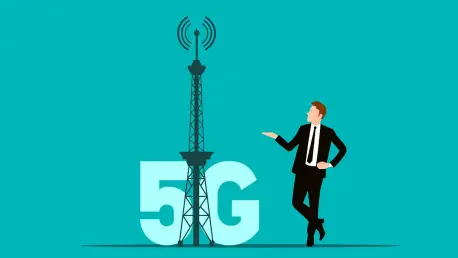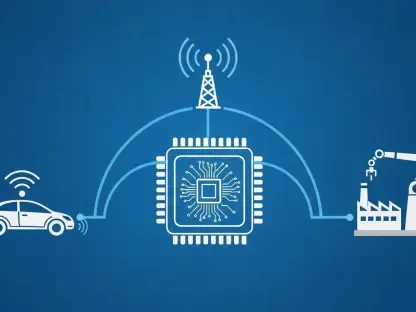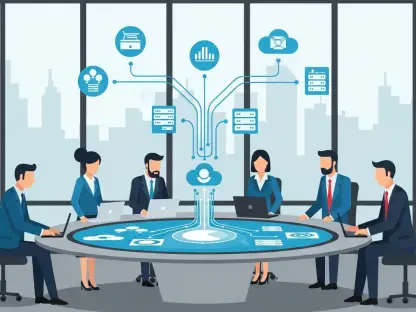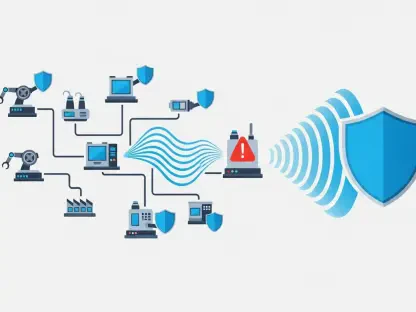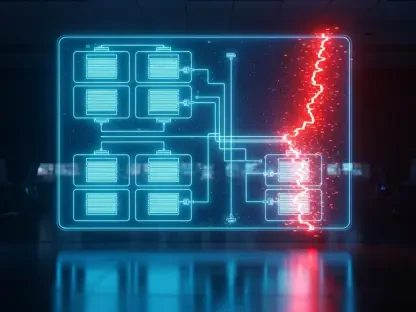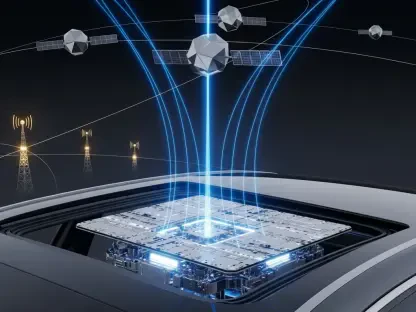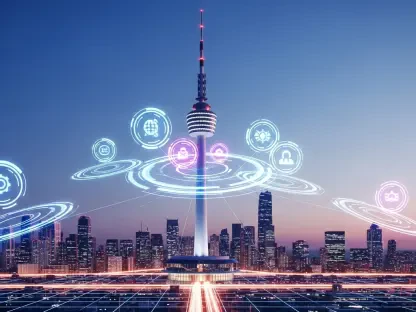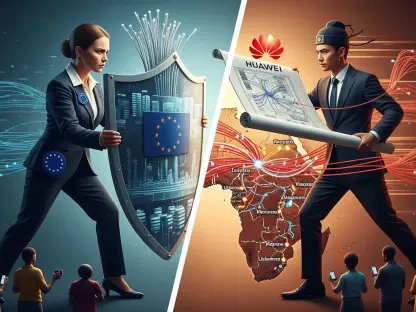As technology races forward in July 2025, the convergence of 5G and the Internet of Things (IoT) stands out as a transformative force, fundamentally altering the landscape of industries, public services, and daily interactions. This isn’t just a small step forward but a seismic shift, driven by 5G’s incredible speeds, near-instantaneous response times, and ability to connect millions of devices without a hitch. From smart factories to connected ambulances, the impact is profound, touching nearly every corner of modern life. What was once a vision of the future has become a tangible reality, marking this moment as a critical turning point where innovation meets practical application. This article explores the depth of this technological wave, delving into how 5G empowers IoT to drive automation, efficiency, and real-time solutions across diverse sectors. The focus is on the present, showcasing the strides made and the potential yet to be unlocked as industries adapt to this powerful synergy.
Technological Foundations of the 5G-IoT Boom
Core 5G Features Fueling IoT Growth
The backbone of the current IoT surge lies in 5G’s core strengths: unmatched data speeds, latency reduced to mere milliseconds, and the ability to connect a huge number of devices at once. These features aren’t just technical terms but the key drivers enabling real-time data processing that powers everything from autonomous vehicles navigating busy streets to industrial systems optimizing production lines. Unlike earlier network generations, 5G supports the massive scale and speed required for IoT ecosystems to thrive, ensuring that devices communicate instantly and reliably. This capability is crucial for applications where even a split-second delay can mean the difference between success and failure, such as in emergency response systems or high-speed transport networks. The foundation laid by 5G is what allows IoT to move beyond niche uses into widespread, transformative adoption across multiple fields, setting a new standard for connectivity.
Beyond the raw power of 5G, its design is built to handle the density of modern IoT environments, where millions of sensors, machines, and gadgets operate together. This scalability means urban centers can deploy vast networks of smart devices to monitor traffic, pollution, or energy usage without overloading systems. In industrial settings, it leads to seamless coordination between countless automated tools, enhancing precision and reducing downtime. The low latency ensures that data isn’t just transferred quickly but acted upon in real time, a critical factor for scenarios like remote surgeries where every moment counts. As a result, 5G doesn’t merely connect devices—it redefines how they interact, creating a dynamic, responsive web of technology that underpins the ongoing digital transformation. This robust framework is the springboard from which IoT applications leap into groundbreaking areas, proving that connectivity is no longer a barrier but a powerful enabler.
Innovations Like 5G-Advanced and RedCap
Among the most exciting developments pushing IoT forward are innovations such as 5G-Advanced and Reduced Capability (RedCap) devices, which expand the reach and practicality of 5G technology. 5G-Advanced introduces network slicing, a feature that allows telecom providers to allocate specific bandwidth for high-priority IoT applications, such as real-time healthcare monitoring or precision agriculture sensors. This tailored approach ensures that critical tasks get the resources they need without interference from less urgent data traffic. Meanwhile, RedCap devices offer a cost-effective, energy-efficient option, making 5G accessible to a wider range of products like mid-tier wearables, utility meters, and rural monitoring tools. These advancements break down economic and technical barriers, allowing smaller businesses and remote areas to tap into the benefits of high-speed connectivity, thus democratizing IoT deployment.
Furthering this accessibility, RedCap’s low-power design aligns with the growing demand for sustainable tech solutions, cutting energy use in devices that don’t need full 5G capabilities. This is especially impactful for industries like agriculture, where sensors tracking soil conditions or livestock health can run for extended periods without frequent maintenance. On the other hand, 5G-Advanced’s ability to prioritize bandwidth for mission-critical operations is transforming sectors like emergency services, where split-second data transmission can save lives. Together, these technologies ensure that 5G isn’t reserved for high-end applications but serves as a versatile tool across varied needs and budgets. By bridging the gap between cutting-edge performance and practical use, these innovations are speeding up IoT adoption at an unprecedented pace, embedding connected intelligence into the fabric of everyday systems and remote operations alike.
Industry Transformations Through 5G-IoT
Manufacturing and Enterprise Solutions
In the realm of manufacturing and logistics, private 5G networks are becoming a cornerstone of operational excellence, offering businesses unmatched control and security. These dedicated networks enable smart factories to integrate robotic automation and predictive maintenance systems, ensuring machinery runs at peak efficiency while addressing potential failures before they happen. By isolating mission-critical tasks from public network congestion, private 5G delivers consistent performance, which is vital for high-stakes environments where downtime leads to significant financial losses. This customized connectivity empowers enterprises to streamline workflows, cut operational costs, and boost productivity, positioning them at the forefront of industrial innovation. The result is a manufacturing landscape where precision and agility are not just goals but standard practice, driven by real-time data and seamless device communication.
Beyond factory floors, the influence of private 5G extends to logistics, where it enables end-to-end tracking and optimization of supply chains. IoT devices powered by these networks monitor inventory, vehicle routes, and warehouse operations with pinpoint accuracy, minimizing delays and enhancing decision-making. This level of connectivity allows companies to respond quickly to disruptions, whether caused by demand spikes or unexpected bottlenecks. Additionally, the security features built into private networks protect sensitive data from cyber threats, a growing concern as more devices come online. As enterprises adopt this technology, the competitive edge gained through faster, safer, and more reliable operations becomes clear, reshaping how goods are produced and delivered. This shift highlights a broader trend: 5G-IoT isn’t just improving business—it’s redefining the very structure of industrial ecosystems for greater resilience and efficiency.
Healthcare and Public Services
In healthcare, 5G-powered IoT is proving to be a life-saving force, enabling real-time data transmission from connected wearables and emergency vehicles like ambulances. These devices send critical patient information to medical teams before arrival at hospitals, allowing for faster diagnosis and treatment that can mean the difference between life and death. The ultra-low latency of 5G ensures that data streams without delay, supporting remote consultations and even robotic surgeries in areas lacking immediate access to specialists. This connectivity transforms how care is delivered, breaking down geographical barriers and improving response times in emergencies. As a result, patient outcomes improve significantly, especially in critical situations where every second counts, marking a new era of precision and accessibility in medical services that benefits both urban and rural populations.
Meanwhile, public services, especially in smart cities, are using 5G-IoT to enhance urban living through non-invasive, efficient solutions. RedCap-enabled sensors manage traffic flow, optimize street lighting, and monitor energy usage, all without relying on intrusive camera systems. This approach not only improves resource allocation but also respects privacy concerns, building public trust in smart infrastructure. Beyond cities, 5G connectivity supports disaster management by linking sensors that detect environmental changes, providing early warnings for floods or earthquakes. These applications show how 5G-IoT goes beyond convenience to address fundamental societal needs, ensuring safer, more sustainable communities. The integration of such technology into public frameworks highlights a commitment to using advanced tools for the greater good, balancing innovation with ethical considerations in urban and emergency planning.
Economic and Societal Impacts
Market Growth and Economic Projections
The economic implications of 5G-IoT are staggering, with market projections showing explosive growth from $20 billion in 2025 to an estimated $160 billion by 2029, reflecting a compound annual growth rate of about 68%. This surge underscores the technology’s role as a catalyst for global economic transformation, driving investment and job creation across tech and related sectors. With over 116 million 5G-specific IoT connections expected by 2026, adoption is speeding up at a remarkable pace, impacting industries from transportation to retail. This isn’t just a passing trend but a structural shift, as businesses and governments allocate significant resources to harness the potential of connected systems. The ripple effects are felt in innovation hubs and emerging markets alike, positioning 5G-IoT as a cornerstone of economic strategy, fueling competition, and opening new revenue streams for companies quick enough to adapt.
Delving deeper into these numbers, the rapid expansion signals a redefinition of market dynamics, where connectivity becomes a core competitive advantage. Sectors like agriculture benefit from IoT-driven precision farming, increasing yields while cutting costs, while retail uses connected devices for personalized customer experiences, boosting sales. Governments, too, are investing in smart infrastructure to reduce inefficiencies in public spending, further amplifying economic gains. These developments suggest that the value of 5G-IoT extends beyond direct profits to broader societal wealth, as improved productivity and resource management raise standards of living. As this market continues to mature, the focus will likely shift toward integrating these technologies into everyday economic frameworks, ensuring that the benefits of connectivity aren’t limited to tech giants but reach small businesses and public initiatives, fostering inclusive growth.
Sustainability and Cybersecurity Challenges
While the rise of 5G-IoT brings immense opportunity, it also heightens cybersecurity risks as billions of connected devices create a vast target for potential breaches. The sheer volume of data transmitted across networks demands advanced protective measures, such as zero-trust security architectures and end-to-end encryption, to safeguard sensitive information. Industries handling personal or critical data, like healthcare and finance, face increased scrutiny to prevent leaks that could undermine trust and cause financial harm. Addressing these vulnerabilities isn’t optional but essential, as a single breach can have cascading effects across interconnected systems. Efforts to strengthen security are thus a priority, with significant investments aimed at developing robust defenses that evolve with emerging threats, ensuring that the promise of 5G-IoT isn’t overshadowed by preventable risks.
On a positive note, sustainability emerges as a key benefit of 5G-IoT, with innovations like RedCap’s low-power designs reducing energy needs for countless devices. Smart buildings equipped with IoT sensors optimize heating, cooling, and lighting based on real-time usage, cutting energy waste and supporting environmental goals. This alignment of technological progress with eco-friendly practices is evident in urban planning, where connected systems manage resources more efficiently, reducing carbon footprints. Agriculture also benefits as IoT monitors water usage, minimizing waste while maximizing crop health. These advancements reflect a growing recognition that connectivity can serve dual purposes—driving innovation while preserving natural resources. As challenges like cybersecurity are addressed, the sustainable impact of 5G-IoT offers a compelling vision of technology that not only transforms industries but also contributes to a greener, more responsible future.
